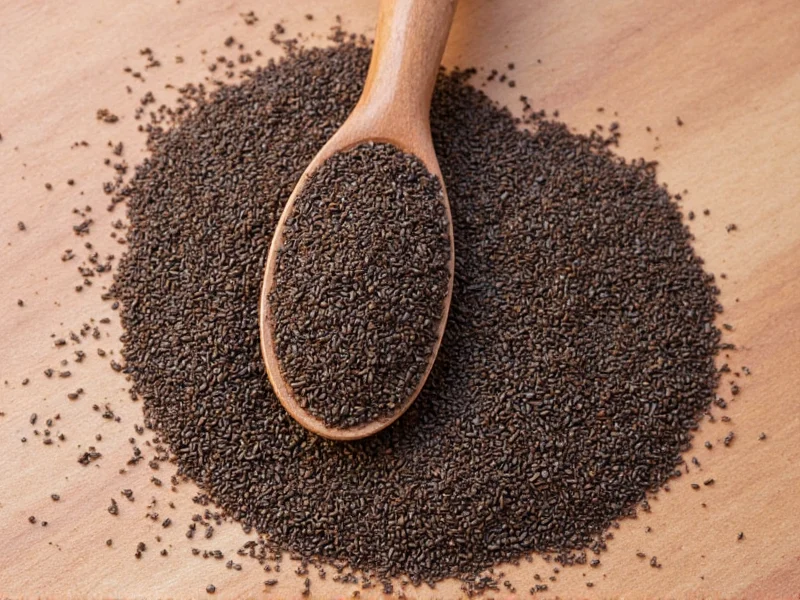Nigella seeds, also known as kalonji or black cumin, are a staple in Middle Eastern, Indian, and Eastern European cuisines. These tiny black seeds offer a distinctive flavor profile—earthy with subtle onion, oregano, and peppery notes—that's challenging to replicate exactly. When you find yourself without nigella seeds for your recipe, understanding the right substitute becomes essential for maintaining dish integrity.
Understanding Nigella Seeds and Their Culinary Role
Nigella sativa seeds measure about 2-3mm in length and have a hard, matte black shell. Unlike true cumin (Cuminum cyminum), nigella belongs to the Ranunculaceae family. Chefs value them for their complex flavor that evolves when toasted—releasing aromatic compounds that enhance breads, curries, pickles, and spice blends. The seeds contain thymoquinone, which contributes to their slightly bitter, medicinal quality that balances rich dishes.
Top Substitutes for Nigella Seeds with Practical Guidance
When selecting a nigella seed replacement, consider both flavor chemistry and culinary context. The following alternatives work best in specific applications, with varying degrees of success depending on your recipe's requirements.
Black Cumin Seeds (Bunium persicum)
Often confused with nigella seeds, black cumin (kala jeera) provides the closest flavor match with its earthy, slightly smoky profile. While nigella has more pronounced onion notes, black cumin offers deeper warmth. Use a 1:1 substitution ratio in Indian curries, rice dishes, and flatbreads. Note that black cumin seeds are longer and thinner than nigella's teardrop shape, so visual presentation differs slightly.
Onion Seeds (Nigella Confusion Explained)
Here's where confusion arises: in many regions, "onion seeds" actually refers to nigella seeds themselves. True onion seeds (from actual onions) don't exist commercially. When recipes call for onion seeds as a nigella substitute, they typically mean fennel seeds—which have a mild licorice flavor rather than onion notes. For dishes requiring nigella's onion-like quality, use 3/4 teaspoon fennel seeds plus 1/4 teaspoon dried onion flakes per teaspoon of nigella seeds.
Fennel Seeds
Fennel seeds provide the anise-like note present in nigella's complex profile. While lacking the peppery bitterness, they work well in breads and vegetable dishes. Toast fennel seeds lightly before use to enhance their aromatic qualities. Use a 3:4 ratio (3/4 teaspoon fennel for 1 teaspoon nigella) to prevent overpowering your dish. This substitution works particularly well in naan bread and Mediterranean vegetable preparations.
Cumin and Caraway Combination
For recipes where nigella's earthy warmth matters more than its onion notes, combine 1/2 teaspoon cumin with 1/2 teaspoon caraway per teaspoon of nigella seeds. Cumin contributes the earthiness while caraway adds the slight citrus note. This blend works exceptionally well in spice rubs, lentil dishes, and hearty stews. The combination creates a more complex flavor profile than either seed alone, better approximating nigella's multidimensional character.
Specialized Substitutes for Specific Applications
Certain dishes require targeted substitutions based on whether you're replacing nigella for flavor, appearance, or both. Consider these specialized alternatives when precision matters:
| Substitute | Best For | Ratio | Flavor Notes |
|---|---|---|---|
| Za'atar blend | Mediterranean flatbreads, dips | 1:1 | Provides similar earthy notes plus thyme and sumac |
| Celery seeds | Pickling, vegetable dishes | 1:1 | Offers comparable bitterness but lacks warmth |
| Sumac | Visual replacement in Middle Eastern dishes | 1:1 | Provides color but tart flavor (use sparingly) |
| Mustard seeds | Indian pickles, tempering | 3/4:1 | Similar pungency but different flavor profile |
When Substitution Becomes Compromise
Understanding the limitations of nigella seed alternatives prevents culinary disappointment. Certain dishes rely specifically on nigella's unique chemical composition that no single substitute can fully replicate. In Bengali panch phoron (five-spice blend), nigella's distinct flavor is irreplaceable. Similarly, Armenian lavash bread traditionally uses nigella for both flavor and visual contrast against the pale dough. In these cases, consider making a special trip to an international market rather than compromising the dish's authenticity.
Practical Tips for Using Substitutes Effectively
Maximize your substitution success with these professional techniques:
- Toast seeds properly: Heat substitutes in a dry pan for 1-2 minutes until fragrant, just as you would nigella seeds
- Adjust timing: Add substitutes at the same stage you'd use nigella seeds in your recipe
- Balance bitterness: If your substitute lacks nigella's slight bitterness, add a pinch of black pepper or lemon zest
- Consider visual impact: For dishes where nigella's black specks matter, combine sumac for color with another seed for flavor
- Start conservative: Use slightly less substitute than the recipe calls for nigella, then adjust to taste
Finding and Storing Nigella Seeds
While substitutes serve well in emergencies, keeping nigella seeds in your pantry prevents future substitution needs. Look for them in Middle Eastern or Indian grocery stores, where they're often sold as "kalonji." Store in an airtight container away from light and heat—properly stored nigella seeds maintain flavor for 1-2 years. For optimal freshness, buy whole seeds rather than pre-ground, as the volatile oils degrade quickly once crushed.











 浙公网安备
33010002000092号
浙公网安备
33010002000092号 浙B2-20120091-4
浙B2-20120091-4